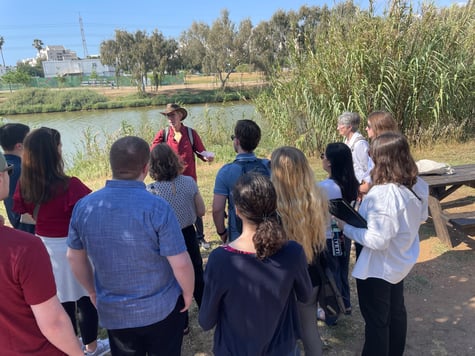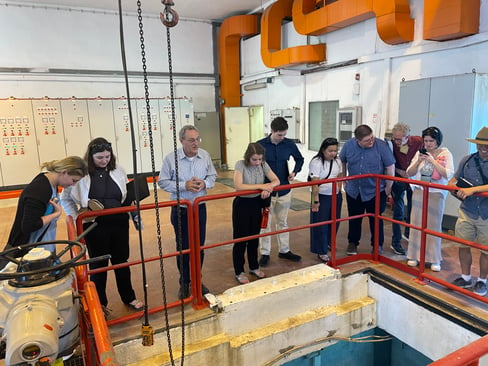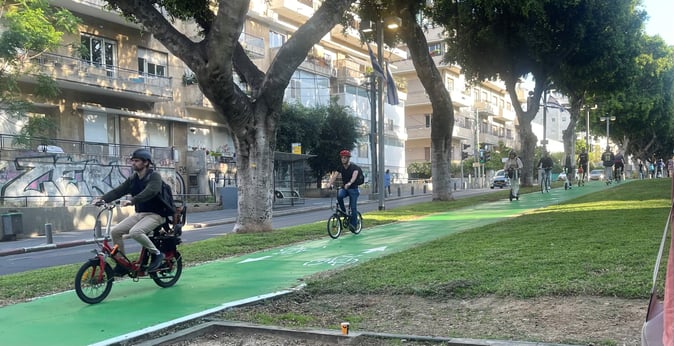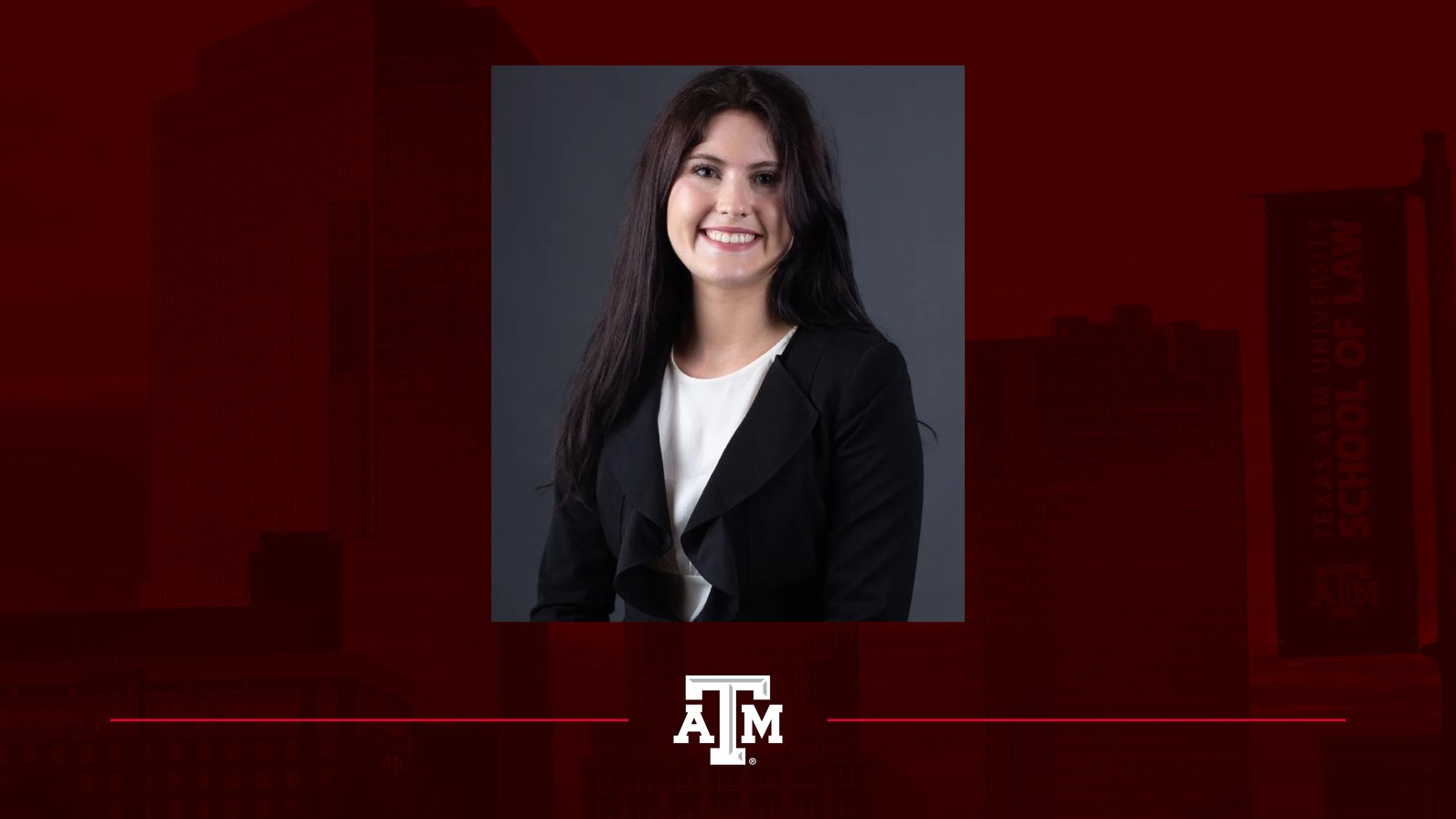Day Two – Tours, Wastewater Treatment Facilities, and Bike Lanes, Oh My!
By: MacKenzie Watson '24
This article is part of a series of reflections prepared by students enrolled in the Texas A&M School of Law 2023 Global Field Studies Program: Israel. Click here to visit the entire series.
After arriving at the hostel in Tel Aviv sometime after 2 a.m., I had opted to skip the breakfast offerings and instead, I woke up around 10:00. It was our first day in Israel and I took advantage of our free morning by exploring the hostel, taking in the environment we would be in for the next few days. The weather was absolutely beautiful, it was about 70 degrees with a nice breeze. I was surprised to hear children’s squeals and I initially thought they were coming from fellow hostel goers. When I looked out the window and saw around two dozen children having what I would assume was recess, it really felt like I was in a foreign country and excitement began to well up.
From there I continued exploring the hostel and stumbled upon leftovers from the morning’s breakfast offerings and helped myself to a delicious chocolate croissant. I further snooped and walked into what seemed like a classroom where there seemed to be coffee, which I was not going to pass up. What I did not realize but would become quickly familiar with was that this was not brewed coffee, in fact, I would not have brewed coffee for the entirety of my time in Israel. Instead, I put the coffee grounds in the bottom of my cup and filled the rest with hot water, mixing the caffeinating concoction the best I could, but flakes remained in the cup and when finished there was a mud-like mixture left at the bottom.
Our first meeting was with our simulated client Clive Lipchin. We had previously met him over Zoom, but this was the group’s first time meeting him in person. We began by introducing ourselves and then we were able to hear from Clive about what he hoped to gain from this experience. He explained to us that he wished to utilize his off-grid wastewater treatment device to serve Bedouin communities living in “unrecognized territories” in Israel and some of the legal challenges he was already facing in pursuing his goals. For me, the meeting made clear that Clive was extremely knowledgeable, and I would learn a lot from him but the legal questions were going to be complex.
 Then, the group met in the lobby of the hostel and got ready for our tour of Tel Aviv. The tour guide’s name was Mikhail, who I assumed was a run-of-the-mill tour guide who would cater to the group’s preferences and provide random facts about the city. Instead, he was a man on a mission that commanded attention with his huge breadth of knowledge and direct experience in the urban planning of Tel Aviv, specifically in transportation.
Then, the group met in the lobby of the hostel and got ready for our tour of Tel Aviv. The tour guide’s name was Mikhail, who I assumed was a run-of-the-mill tour guide who would cater to the group’s preferences and provide random facts about the city. Instead, he was a man on a mission that commanded attention with his huge breadth of knowledge and direct experience in the urban planning of Tel Aviv, specifically in transportation.
The first stop we made was at the Yakon River. I feel it would be a disservice to not tell the story of the fluctuating quality of the Yakon River’s waters. The pollution in the Yakon River had gotten so bad that it was deathly to three world-renowned athletes who fell into the river when a bridge above it collapsed. This was a terrible look for Tel Aviv and the government, so initiatives began from the top down to clean up the river. When the river finally was clean enough to not have fatal consequences for simply standing in the river, a politician made a public display by jumping in the river, declaring it clean. In reality, it still is not very safe for recreational use such as swimming, but we did see many people kayaking and paddle-boating, and it was quite aesthetically beautiful, abutting a bicycle trail that we saw hundreds of people using in the short 15 minutes or so that we stood beside the river.
Next, we made our way to the wastewater treatment facility responsible for treating the sewage of Tel Aviv which is no small task. I was overcome by the fervor of wanting to find the answers for our simulated client, asking questions that I thought would have a clear-cut answer. I quickly found out this was not going to be the case. There seemed to be a sense of pride in running a very efficient and effective wastewater treatment facility, rather than being concerned with the minimum regulatory requirements. We were able to visit the monitoring room where there were 7 monitors and large logbooks that were meant to be written in every hour, if not more frequently. We were told this was well above and beyond the minimum reporting requirements enacted by Israel, and they were not really concerned with the requirements, but rather providing and ensuring that the wastewater is treated to a high enough quality for agricultural use.

The next portion of our tour took place in the central part of Tel Aviv where there was constant bustling of people and bike riders, like lots and lots of bike riders. Mikhail explained to us that he was actually part of a bottom-up initiative that he started along with other bike riders in the city who saw an opportunity for a sophisticated bike transportation system in the city. It was apparent that the bike lanes were extremely useful. There were literally thousands of people using the bike lanes, and traffic never seemed overly burdensome. Overall, in terms of foot, bike, and automobile traffic Tel Aviv ran very smoothly. Not to mention the environmental impact that the bike lanes have by decreasing the number of cars on the road. It was surprising that such a large and likely expensive project began at the grassroots level. It showed me that the interests of citizens at a grassroots level and the interests of the governmental bodies tasked with running the city are not exclusive, and in fact, it is when these interests converge and everyday citizens and larger governmental bodies engage in cooperative action that the most effective initiatives are instituted.

After we had eaten dinner, a large group of us students decided to explore Tel Aviv. It became quickly apparent that we were wandering aimlessly with no real destination in mind, and we separated in two groups at this point, those who wanted to get some rest for the next day and those who wanted to continue exploring the city. After about an hour more of walking, Ian, in whom I had placed complete trust to know where we were and where we were going, let the rest of us know there was a path along the shore of the Mediterranean that we could take back to the hostel. So, of course, we all took our shoes off and enjoyed the sand between our toes and the sounds of water splashing upon the shore on our way back as opposed to the typical sounds and horn-honking in a concrete jungle like Tel Aviv. It was nice, we began to get to know each other better and talk about where we were from. It was just the very beginning of our trip and I felt like I had already learned so much, but I could not imagine the breadth of information I would learn and the experiences I would have over the next two weeks.
Learn more about Texas A&M University School of Law's Global Law and Policy Program, Aggie Dispute Resolution Program, and Energy, Environmental, and Natural Resource Systems Law Program
